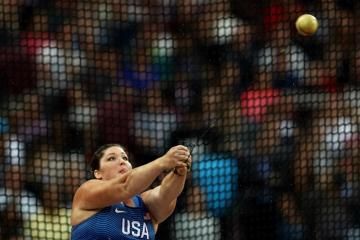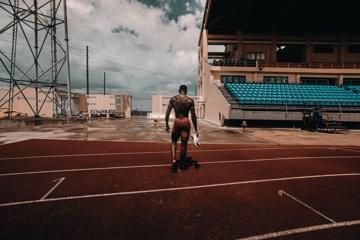Joe Kovacs
by Joe Kovacs
I call it the kitchen talk. It was February 2019, and I was on the cusp of walking away from the sport.
My Mom and Stepdad were there, along with my wife, Ashley, a woman I can always trust to give it to me straight. That day she didn't hold back.
“If you want to quit you can, I’m going to support you either way,” she said. “But, I don’t really understand why you think you can’t throw far anymore. Either way, this half-in, half-out stuff has to go. I’m tired of looking at it.”
Something had to change, and I knew it. I had just competed at a meet in Columbus, Ohio, where I had a best of 19.52m. I was beaten by a Chinese athlete I coach, Wu Jiaxing.
My Mom had driven for seven hours to watch me compete, and that was the best I could do. In the kitchen that evening she started the conversation with something like, “Hey, you had a good run.”
That was her way of giving me an out, of saying if I wanted to walk away now, they would still love and support me.
At the time I was being coached remotely by Art Venegas, who knew me like a son and had guided me to the greatest achievements of my career. The changes we'd made to my technique in 2018 hadn't worked out and for many months, Art had pushed me to let Ashley take over my coaching. At that point it felt right to give it a try.
One of the things I abide by in the shot put is: make the ball go far. If you foul or mess up, fine, but you have to see that ball going far. Shot putters are human cannons. It comes down to a physics equation: velocity, height of release and angle of release.
The height is how tall you are, the angle is decided by whether you have good technique or bad technique, which can change by the day. The velocity is the true measurement of power, and if you don't have that you don't have a chance. It’s why you could take a decathlete or sprinter and teach them the best technique in the world but if they don’t have the power, the ball is not going to go far.
Early last year, I was no longer seeing the ball go far.
Ashley decided to take command: “Let’s just see what we can do from here. You have a week to USAs and you don't really care about indoors, so let's just clean it up and get off on the right foot for the outdoor season.”
The following weekend, I improved by two meters to finish second at the US Indoor Championships with 21.40m. Okay, I told myself, we’re not that far off.
The previous year had been the worst of my career performance-wise, but despite that I was happy. The reason was Ashley.
I knew who she was long before we met. She went to the University of Kentucky and I went to Penn State, and both of us were good throwers in college. A family friend of ours is from Canton, Ohio and when we’d go visit him, he’d always tell me about this girl from North Canton who was really good at the shot put. That was Ashley.
We were always friendly but it wasn't until the summer of 2017 that we really started dating, at which point she was the throws coach at Ohio State University. I knew early on she was the one, and we married in November 2018.
That same month, she was selected as the US men’s throws coach for the 2019 World Championships in Doha and, while I was so happy for her to be recognized like that, the doomsday scenario for me was to be sitting at home watching on TV as my wife coached my rivals in a world final. I had to make that team.
It became very apparent soon after working with her that she wasn’t just a great match as a wife, but also as a coach. In the gym I was only trying to maintain strength, but under her guidance I started to lift heavier and to move faster than ever before.
Away from coaching, Ashley is really nice and always sweet to me but at the track she’s all business. She’s focused, intense, commanding and very detail-oriented. She has tunnel vision on the task at hand and if you're not performing at your optimum level, you're wasting everyone's time. If I was one of her college kids, I’d would make sure to stay in line, but with me she's very different.
It’s a collaboration. We don't talk about shot put all the time, but that’s not to say there's not an evening where we're on the hardwood floor at home, practicing something in a pair of socks. My job has to be at such a high level so it doesn't really end at the track – it has to do with food, recovery, sleep. As a result I rely on Ashley more than any normal coach, and that's where I have a huge advantage, because I trust her.
When I get out of bed, she can tell within that first moment what the day is going to be like – even before I know. After heavy lifting I can often have glazed eyes because my central nervous system is fried and when she sees that, she’ll alter the day’s training.
Her ability to recognize that is what allowed me win gold at the World Championships. The Sunday before that shot put final, I had an awesome practice in Doha, the kind you get only a couple times a year.
The next day we were due to do some drills, but when I got to the track I was flopping all over the ring. Ashley looked at my eyes and saw them glazed over. She knew I was run down.
In the past, I’d have sucked it up and found a way to keep practicing at a high level, which would just drain me even more. With my previous coach, Art, I’d always try to put on a good show, but I can’t fake it for Ashley. She knows me too well.
That day she said, “I don’t want to see you outside of your room all day, you need to be laying down, in the dark and recover. That’s your job today.”
She quarantined me in my room for a full day. The second day, I was only allowed to leave to eat. I was watching terrible Netflix shows to pass the time, sleeping as much as possible and resting with my blinds closed, trying to restore my central nervous system.
The morning of the shot put final, I woke up feeling recharged and it was a very odd feeling: there was no nerves at all, it was as if I was going to practice.
When I got called out for the introductions, I pointed to my wedding ring and I remember thinking: okay, even if this goes badly, I’m still happy and in a good place. It was the first time I had been in a meet where the result of the day wasn’t my end all be all.
Halfway through the competition, I was in fourth place with a best of 21.63m but Tom Walsh, Ryan Crouser and Darlan Romani had already gone way beyond 22 meters. I spoke to Ashley, who was very direct. “No safe throws,” she said. “A 22-meter throw is the same as a foul.”
In practice the previous Sunday, I had three throws farther than my personal best, so I knew it was there. Going into the final round, Ashley didn’t even have to say it but I could tell from her tone what the message was.
Six months ago you were ready to quit and go get a normal job and you thought you sucked. Now you're on 22 meters in fourth place. Who cares? Swing for the fences.
The last thing she said was: “I either want to see a far throw that's a foul or a far throw that's a PR.”
As shot putters we spend a lifetime trying to perfect such small things. Everybody thinks that we're spinning in a circle, but we're really sprinting in a line and our body happens to be spinning around that. To get it right, I want to make sure I'm sprinting down into the throw, that I'm facing the throw with my eyes and chest as long as I can. You try to catch all the potential energy in your tendons and muscles and redirect it right back into the ball.
It’s like a golf swing: there are times you have that feeling where it just winds up and after release you just want to say, hell yeah.
The final throw in Doha was one of those. When I saw 22.91m I didn’t even realize it was the lead, I just knew I’d smashed my PR. In the end took gold by 1cm, and there’s no doubt in my mind that the difference was in Ashley’s decision a few days earlier: to pull back and force me to rest instead of pushing myself into a hole.
I ran over to her and basically pulled her out of the crowd, and it was an amazing moment for both of us.
Everybody always asks me about the high of that competition, but I can't think about it without looking back to the kitchen talk seven months earlier. The resolution of that conversation was that there were too many cooks in the kitchen and I wasn’t listening to anybody – not even myself.
The decision I made that night was to buy into Ashley, to have total trust and go all-in. It was the best one I ever made.







